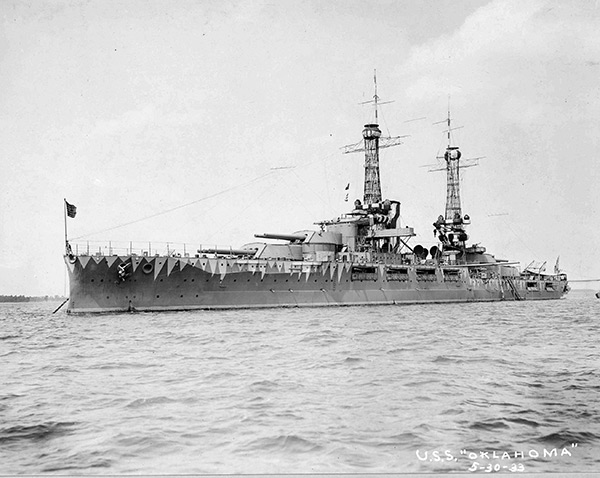|
|
|
| Missing In Action (MIA) | Prisoners Of War (POW) | Unexploded Ordnance (UXO) |
| Chronology | Locations | Aircraft | Ships | Submit Info | How You Can Help | Donate |
|
| USN Nevada-class battleship 27,500 Tons 583' x 95.3' x 28.5' 10 × 14" guns 8 × 5" guns 2 × 21" torpedo tubes 2 floatplanes 1 catapult in 1942  USN c1917  USN c1940  USN November 3, 1943  USN December 31, 1943  Justin Taylan 2010 |
Ship History Built by the New York Shipbuilding Corporation of Camden, New Jersey. Laid down October 26, 1912 as a Nevada-class battleship. Launched March 23, 1914 as USS Oklahoma (BB-37) sponsored by Miss Lorena J. Cruce. Commissioned May 2, 1916 at Philadelphia, PA with Captain Roger Welles in command. She was the last ship of the U.S. Navy to with vertical triple expansion (VTE) reciprocating machinery instead of steam turbines and had a vibration problem as a result of this power pant. World War I Service Assigned to the Atlantic Fleet with Norfolk, Virginia as her home port and conducted training exercises off the east coast of the United States. In 1917 painted in an experimental camouflage pattern. On August 13, 1918 departed with USS Nevada (BB-36) to protect Allied convoys in the Atlantic Ocean bound for Europe. Inter War Years Part of the escort for U.S. President Woodrow Wilson to France, departing December 14, 1918 for New York City and winter fleet exercises off Cuba. She returned to Brest, France on June 15, 1919 to escort President Wilson in George Washington home from his second visit to France, returning to New York on July 8, 1919. Oklahoma was part of the Atlantic Fleet for the next two years, and was overhauled, trained, and twice voyaged to South America's west coast; early in 1921 for combined exercises with the Pacific Fleet, and later that year for the Peruvian Centennial. She then joined the Pacific Fleet for six years highlighted by the cruise of the Battle Fleet to Australia and New Zealand in 1925. During early 1927, joined the Scouting Fleet with intensive exercises during the summer Midshipmen Cruise, voyaging to the East Coast to embark midshipmen, then transport them via the Panama Canal to San Francisco, then returned via Cuba and Haiti. After being modernized at Philadelphia between September 1927 and July 1929, Oklahoma rejoined the Scouting Fleet for exercises in the Caribbean Sea, and then returned to the west coast in June 1930 for fleet operations through spring 1936. That summer she carried midshipmen on a European training cruise, visiting northern ports. The cruise was interrupted with the outbreak of the Spanish Civil War. Oklahoma arrived at Bilbao on July 24, 1936 to rescue American citizens and other refugees, transporting them to Gibraltar and France. Afterwards, arrived at Norfolk, VA on September 11, 1936 and steamed to the West Coast arriving October 24, 1936. December 4, 1941 during the night, USS Arizona (BB-39), USS Nevada (BB-36) and USS Oklahoma conduct training and live fire exercise then returned on December 5, 1941 in the morning. Sinking History On December 7, 1941 Oklahoma was moored at Battleship Row alongside USS Maryland BB-46 in Pearl Harbor. During the first wave of the Japanese attack, Oklahoma was hit by three aerial torpedoes. As she began to capsize, two more torpedoes impacted, and the crew were strafed as they abandoned ship. Within twenty minutes of being hit, she rolled over until her masts touched the bottom, leaving her starboard side and part of her keel above water. Oklahoma received one battle star for her World War II service. Fates of the Crew In total, 20 officers and 395 enlisted men were either killed or missing and 32 wounded. One of those killed, Father Aloysius Schmitt was the first American chaplain of any faith to die in the Second World War. Many of the surviving crew managed to climbed aboard USS Maryland BB-46 and helped operate her anti-aircraft guns for the remainder of the attack. Meanwhile, many of her crew were trapped inside the capsized hull. Immediately after the attack, heroic efforts were made in an attempt to rescue more crew members. In one effort, civilian Navy yard worked, Julio DeCastro organized a team that rescued 32 sailors. Salvage During March 1943, salvage operations commence. Over eight months, the battleship is prepared to be refloated. On November 3, 1943 refloated. On December 28, 1943 enters dry dock but was determined to be too damaged. Decommissioned September 1, 1944 and stripped of for usable parts including the guns, superstructure and other usable equipment. On December 5, 1946 sold for scrap to Moore Dry Dock Company of Oakland. Oklahoma was to be towed from Pearl Harbor to San Francisco to be scraped. Sinking History On May 17, 1947 while being towed during a storm, Oklahoma sank roughly 540 miles off Oahu in the Pacific Ocean. Memorial A memorial of black marble and white pillars with each member of the crew killed in action is is located on Ford Island, near USS Missouri BB-63. References NavSource USS Oklahoma BB-37 WFI Research Group - USS Oklahoma Contribute
Information Last Updated
|
Photo Archive |
| Discussion Forum | Daily Updates | Reviews | Museums | Interviews & Oral Histories |
|